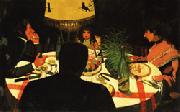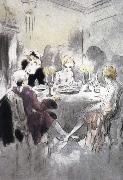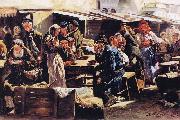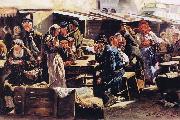Wholesale Oil Painting Reproductions No Minimum and Door to Door! |
|||||||||||
|
|
|||||||||||

|
|||||||||||
|
|
|
||||||||
All Felix Vallotton Oil Paintings |
||||||||
|
|
||||||||
|
|
||||||||
|
Artist Introduction: 1865-1925was a Swiss painter and printmaker associated with Les Nabis. He was an important figure in the development of the modern woodcut. He was born into a conservative middle class family in Lausanne, and there he attended College Cantonal, graduating with a degree in classical studies in 1882. In that year he moved to Paris to study art under Jules Joseph Lefebvre and Gustave Boulanger at the Academie Julian. He spent many hours in the Louvre, where he greatly admired the works of Holbein, Derer and Ingres; these artists would remain exemplars for Vallotton throughout his life.[1] His earliest paintings, such as the Ingresque Portrait of Monsieur Ursenbach (1885), are firmly rooted in the academic tradition, and his self portrait of 1885 (seen at right) received an honorable mention at the Salon des artistes français in 1886. During the following decade Vallotton painted, wrote art criticism and made a number of prints. In 1891 he executed his first woodcut, a portrait of Paul Verlaine. The many woodcuts he produced during the 1890s were widely disseminated in periodicals and books in Europe as well as in the United States, and were recognized as radically innovative in printmaking. They established Vallotton as a leader in the revival of true woodcut as an artistic medium; in the western world, the relief print, in the form of commercial wood engraving, had long been mainly utilized unimaginatively as a medium for the reproduction of drawn or painted images and, latterly, photographs. Vallotton's starkly reductive woodcut style features large masses of undifferentiated black and areas of unmodulated white. While emphasizing outline and flat patterns, Vallotton generally made no use of the gradations and modeling traditionally produced by hatching. The influences of post-Impressionism, symbolism and the Japanese woodcut are apparent; a large exhibition of ukiyo-e prints had been presented at the École des Beaux-Arts in 1890, and Vallotton, like many artists of his era an enthusiast of Japonism, collected these prints. He depicted street crowds and demonstrations including several scenes of police attacking anarchists bathing women, portrait heads, and other subjects which he treated with a sardonic humor. His graphic art reached its highest development in Intimit's (Intimacies), a series of ten interiors published in 1898 by the Revue Blanche, which deal with tension between men and women. Vallotton's prints have been suggested as a significant influence on the graphic art of Edvard Munch, Aubrey Beardsley, and Ernst Ludwig Kirchner .By 1892 he was affiliated with Les Nabis, a group of young artists that included Pierre Bonnard, Ker-Xavier Roussel, Maurice Denis, and Edouard Vuillard, with whom Vallotton was to form a lifelong friendship. During the 1890s, when Vallotton was closely allied with the avant-garde, his paintings reflected the style of his woodcuts, with flat areas of color, hard edges, and simplification of detail. |
||||||||
|
|
||||||||
|
Dinner Painting ID:: 11736 |
by Lamplight,1899
1' 10 1/2'' x 2' 11 1/4''(57 x 89.5 cm) |
|||||||
Height Width |
INS/CM Quality |
|||||||
|
X |
| |||||||
|
|
||||||||
All Louis Lcart Oil Paintings |
||||||||
|
|
||||||||
|
|
||||||||
|
Artist Introduction: French (1880-1950)
Louis Icart was born in Toulouse, France. He began drawing at an early age. He was particularly interested in fashion, and became famous for his sketches almost immediately. He worked for major design studios at a time when fashion was undergoing a radical change-from the fussiness of the late nineteenth century to the simple, clingy lines of the early twentieth century. He was first son of Jean and Elisabeth Icart and was officially named Louis Justin Laurent Icart. The use of his initials L.I. would be sufficient in this household. Therefore, from the moment of his birth he was dubbed 'Helli'. The Icart family lived modestly in a small brick home on rue Traversi??re-de-la-balance, in the culturally rich Southern French city of Toulouse, which was the home of many prominent writers and artists, the most famous being Henri de Toulouse-Lautrec.
Icart fought in World War I. He relied on his art to stem his anguish, sketching on every available surface. It was not until his move to Paris in 1907 that Icart would concentrate on painting, drawing and the production of countless beautiful etchings, which have served (more than the other mediums) to indelibly preserve his name in twentieth century art history. When he returned from the front he made prints from those drawings. The prints, most of which were aquatints and drypoints, showed great skill. Because they were much in demand, Icart frequently made two editions (one European, the other American) to satisfy his public. These prints are considered rare today, and when they are in mint condition they fetch high prices at auction.
Art Deco, a term coined at the 1925 Paris Exposition des Arts Decoratifs, had taken its grip on the Paris of the 1920s. By the late 1920s Icart, working for both publications and major fashion and design studios, had become very successful, both artistically and financially. His etchings reached their height of brilliance in this era of Art Deco, and Icart had become the symbol of the epoch. Yet, although Icart has created for us a picture of Paris and New York life in the 1920s and 1930s, he worked in his own style, derived principally from the study of eighteenth-century French masters such as Jean Antoine Watteau, François Boucher and Jean Honor?? Fragonard.
In Icart's drawings, one sees the Impressionists Degas and Monet and, in his rare watercolors, the Symbolists Odilon Redon and Gustave Moreau. In fact, Icart lived outside the fashionable artistic movements of the time and was not completely sympathetic to contemporary art. Nonetheless, his Parisian scenes are a documentation of the life he saw around him and they are nearly as popular today as when they were first produced.
In 1914 Icart had met a magical, effervescent eighteen-year-old blonde named Fanny Volmers, at the time an employee of the fashion house Paquin. She would eventually become his wife and a source of artistic inspiration for the rest of his life. |
||||||||
|
|
||||||||
|
|
Dinner Painting ID:: 63431 |
mk286 14 x 19.4 cm |
||||||
Height Width |
INS/CM Quality |
|||||||
|
X |
| |||||||
|
|
||||||||
All Vladimir Makovsky Oil Paintings |
||||||||
|
|
||||||||
|
|
||||||||
|
Artist Introduction: (Russian: 26 January (greg.: 7 February) 1846, Moscow - 21 February 1920, Petrograd) was a Russian painter, art collector, and teacher.
Portrait by Vladimir Makovsky of Empress Maria Fyodorovna. Gatchina Palace, 1885Makovsky was the son of collector, Yegor Ivanovich Makovsky, who was one of the founders of the Moscow Art School. Vladimir had two brothers, Nikolai Makovsky and Konstantin Makovsky, and one sister, Alexandra Makovsky, all of whom were famous painters. Vladimir studied at the Moscow School of Painting, Sculpture, and Architecture. He finished his studies in 1869 and the following year became one of the founding members of the Association of Travelling Art Exhibitions, where his many years of prolific work brought him to a leading position
Makovsky's work was defined by a perpetual humor as well as blatant irony and scorn. During the seventies his paintings dealt primarily with small-town folk. His pictures, "The Grape-juice Seller" (1879), "Fruit-Preserving" (1876) and "The Congratulator" (1878) depict various scenes where the mood is finely conceived and almost laughter-inducing. Other works of his, such as "The Benefactor" (1874) and "The Convict" (1878) are profoundly socially-conscious. In them, Makovsky either criticizes the false sympathy of the aristocracy towards the poor, or draws attention to the oppression and persecution by the tsarist gendarmerie. In 1878, he became an academician.
In the eighties, during the time of Russian "democratic" painting, Makovsky produced some of his most valued works. In 1882, he was made professor at the Moscow Art School after the death of Vasili Perov. Some of Makovsky's greatest works of this period include "In the Ante-room of the Court of Conciliation" (1880), "The Released Prisoner" (1882), and "The Collapse of the Bank" (1881). From the end of the 1880s, Makovsky began to produce more gloomy works. Quintessential works of this period include "You Shall Not Go" (1892), and "On the Boulevard" (1888).
In 1894, Makovsky became Rector of the Preparatory school of the Academy of Art. After the First Russian Revolution, he painted "January 9, 1905, on Vasilyev Island" in which he depicts the armed police firing at defenseless people. In another painting "The Sacrifices on the Khodyn Field" in which a thousand people lost their lives during the coronation ceremony in 1896 of Nicholas II, he again stood uncompromisingly on the side of the oppressed people. After the 1917 October Revolution, Makovsky helped carry over the realist traditions to the early stages of Socialist Realism.
|
||||||||
|
|
||||||||
|
|
Dinner Painting ID:: 72059 |
oil painting
1875(1875)
|
||||||
Height Width |
INS/CM Quality |
|||||||
|
X |
| |||||||
|
|
||||||||
All Vladimir Makovsky Oil Paintings |
||||||||
|
|
||||||||
|
|
||||||||
|
Artist Introduction: (Russian: 26 January (greg.: 7 February) 1846, Moscow - 21 February 1920, Petrograd) was a Russian painter, art collector, and teacher.
Portrait by Vladimir Makovsky of Empress Maria Fyodorovna. Gatchina Palace, 1885Makovsky was the son of collector, Yegor Ivanovich Makovsky, who was one of the founders of the Moscow Art School. Vladimir had two brothers, Nikolai Makovsky and Konstantin Makovsky, and one sister, Alexandra Makovsky, all of whom were famous painters. Vladimir studied at the Moscow School of Painting, Sculpture, and Architecture. He finished his studies in 1869 and the following year became one of the founding members of the Association of Travelling Art Exhibitions, where his many years of prolific work brought him to a leading position
Makovsky's work was defined by a perpetual humor as well as blatant irony and scorn. During the seventies his paintings dealt primarily with small-town folk. His pictures, "The Grape-juice Seller" (1879), "Fruit-Preserving" (1876) and "The Congratulator" (1878) depict various scenes where the mood is finely conceived and almost laughter-inducing. Other works of his, such as "The Benefactor" (1874) and "The Convict" (1878) are profoundly socially-conscious. In them, Makovsky either criticizes the false sympathy of the aristocracy towards the poor, or draws attention to the oppression and persecution by the tsarist gendarmerie. In 1878, he became an academician.
In the eighties, during the time of Russian "democratic" painting, Makovsky produced some of his most valued works. In 1882, he was made professor at the Moscow Art School after the death of Vasili Perov. Some of Makovsky's greatest works of this period include "In the Ante-room of the Court of Conciliation" (1880), "The Released Prisoner" (1882), and "The Collapse of the Bank" (1881). From the end of the 1880s, Makovsky began to produce more gloomy works. Quintessential works of this period include "You Shall Not Go" (1892), and "On the Boulevard" (1888).
In 1894, Makovsky became Rector of the Preparatory school of the Academy of Art. After the First Russian Revolution, he painted "January 9, 1905, on Vasilyev Island" in which he depicts the armed police firing at defenseless people. In another painting "The Sacrifices on the Khodyn Field" in which a thousand people lost their lives during the coronation ceremony in 1896 of Nicholas II, he again stood uncompromisingly on the side of the oppressed people. After the 1917 October Revolution, Makovsky helped carry over the realist traditions to the early stages of Socialist Realism.
|
||||||||
|
|
||||||||
|
|
Dinner Painting ID:: 73568 |
English: oil painting
Date 1875
cyf |
||||||
Height Width |
INS/CM Quality |
|||||||
|
X |
| |||||||
|
|
||||||||
|
Prev Next
|
||||||||
|
|
||||||||
|
Related Paintings to Vladimir Makovsky :. |
||||||||
|
|
||||||||
|
CONTACT US |




